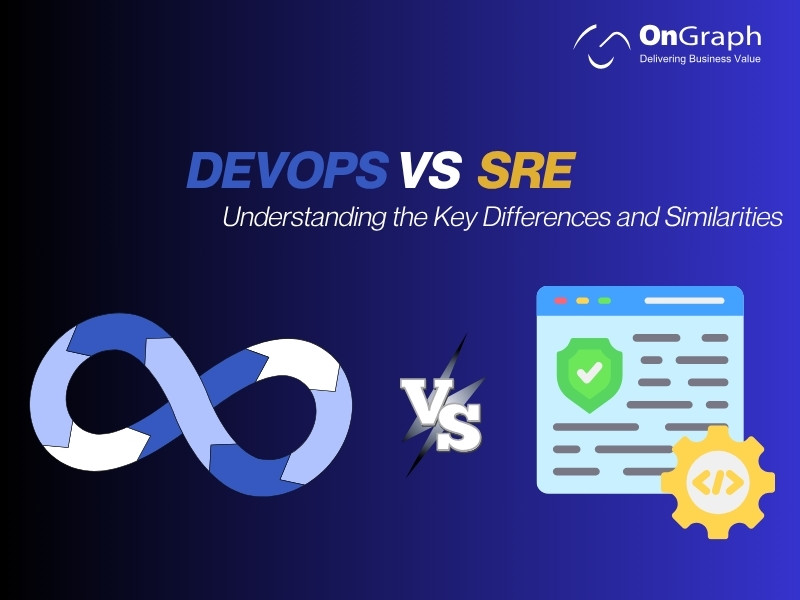In today’s software world, the debate of SRE vs DevOps is more relevant than ever. As companies push for faster releases, better uptime, and efficient operations, both Site Reliability Engineering (SRE) and DevOps have become central to modern IT strategies.
While these two concepts may sound similar, they are not the same. In this blog, we’ll explain the difference between SRE and DevOps, compare their roles, and show how they can work together to improve software delivery and reliability.
What Is DevOps?
DevOps is a cultural and technical approach that focuses on collaboration between development and operations teams. The goal is to build, test, and release software faster and more reliably.
Key practices include:
- Continuous Integration and Continuous Delivery (CI/CD)
- Infrastructure as Code (IaC)
- Monitoring and automation
- Fast feedback loops
What Is SRE?
Site Reliability Engineering (SRE) is a role and a practice developed at Google. It applies software engineering principles to operations tasks. Instead of manual processes, SREs build tools and automation to manage infrastructure and reliability.
Key responsibilities:
- Set and monitor Service Level Objectives (SLOs)
- Automate incident responses
- Manage system reliability and error budgets
- Conduct post-incident reviews
Site Reliability Engineer vs DevOps: SREs focus more on how to maintain reliability at scale, using engineering. DevOps is about bringing teams together for faster delivery.
SRE vs DevOps: What’s the Difference?
Let’s break down the difference between SRE and DevOps:
| Category | DevOps | SRE |
| Focus | Collaboration & delivery speed | Reliability & system stability |
| Origin | Culture & practice | Role & engineering discipline |
| Main Tools | CI/CD, IaC, automation pipelines | Monitoring, error budgets, and custom tools |
| Team Structure | Shared responsibilities | Dedicated SRE teams |
| Failure Handling | Prevent failure through DevOps practices | Accept some failure and manage risk |
For example:
- DevOps pushes code changes faster. SRE ensures the changes don’t crash the system.
- DevOps handles collaboration. SRE builds the systems to keep everything reliable.
- Together, they reduce downtime and improve customer satisfaction.
Real-World Example: How DevOps and SRE Worked for an E-commerce App
Background:
An e-commerce startup wanted to reduce downtime during high-traffic seasons like Diwali and Black Friday. Their DevOps team had automated deployments but struggled with unpredictable crashes and scaling issues.
Solution:
They hired two SREs to work with the DevOps team.
- SREs created detailed SLOs and error budgets.
- They built auto-scaling tools and improved monitoring dashboards.
- Post-mortems were introduced after incidents to find root causes.
Results:
- 48% fewer production incidents
- 32% faster recovery times
- 99.97% uptime during holiday campaigns
Key takeaway: When DevOps SRE teams work together, businesses can move fast without breaking things.
Statistics That Show the Value of DevOps and SRE
- According to the 2024 DORA Report, elite DevOps teams deploy 973x more frequently than low performers.
- Google’s internal data shows that teams using SRE practices have 5x faster incident resolution times.
- LinkedIn’s engineering blog shared that combining DevOps and SRE reduced their system downtime by 35% year over year.
Hire DevOps Developer with SRE Understanding
If your goal is to deliver stable software at speed, you need developers who understand both cultures. At OnGraph, we help you hire DevOps developers who also understand SRE development principles, ensuring your teams are equipped to manage infrastructure, delivery pipelines, and uptime goals effectively.
Final Thoughts
The SRE vs DevOps comparison isn’t about picking one over the other. It’s about blending the strengths of both. While DevOps ensures fast delivery through collaboration and automation, SRE ensures that speed doesn’t come at the cost of stability.
The best engineering teams in 2025 will use both models to scale efficiently, reduce downtime, and keep customers happy.
FAQs
The key difference lies in the approach. DevOps is a cultural movement focused on collaboration between development and operations teams to deliver software quickly and reliably. SRE (Site Reliability Engineering), on the other hand, is a role-based approach where engineers apply software development skills to operations tasks. While DevOps is broad and principle-driven, SRE is more prescriptive and engineering-focused.
No, SRE does not replace DevOps. In fact, they complement each other. DevOps sets the cultural and organizational framework, encouraging collaboration and fast delivery. SRE brings structured practices like error budgeting, incident management, and automation to improve system reliability within that DevOps culture. Most mature organizations use both in parallel.
A Site Reliability Engineer (SRE) is responsible for:
- Ensuring system availability and performance
- Creating and maintaining Service Level Objectives (SLOs) and Service Level Indicators (SLIs)
- Managing incident responses and postmortems
- Automating repetitive operational tasks
- Building monitoring and alerting systems
Enforcing error budgets to balance reliability and speed
For startups, DevOps is often the better starting point. It promotes agility, quick delivery, and lean operations. As the product and infrastructure grow more complex, startups can gradually integrate SRE practices to manage scale, uptime, and reliability. Many successful startups begin with DevOps and adopt SRE as they mature.
DevOps teams focus on building and releasing applications rapidly. SRE teams ensure those applications run smoothly and meet performance expectations. For example, when DevOps pushes a new release, SRE ensures the deployment doesn’t violate any service-level objectives. Together, they create a balance between speed and stability.
An error budget is the maximum allowable downtime or failure within a given time frame, based on the system’s Service Level Objective (SLO). For example, if a service has a 99.9% uptime goal, the error budget allows 0.1% downtime. If the team exceeds this limit, new feature releases may be paused until reliability is restored. It’s a way to balance innovation with operational stability.
Look for candidates with:
- Experience in both development and IT operations
- Knowledge of CI/CD, infrastructure automation, and monitoring tools
- Familiarity with incident management, SLIs/SLOs, and error budgets
A mindset geared toward both delivery and reliability
About the Author
Let’s Create Something Great Together!
Latest Blog
















